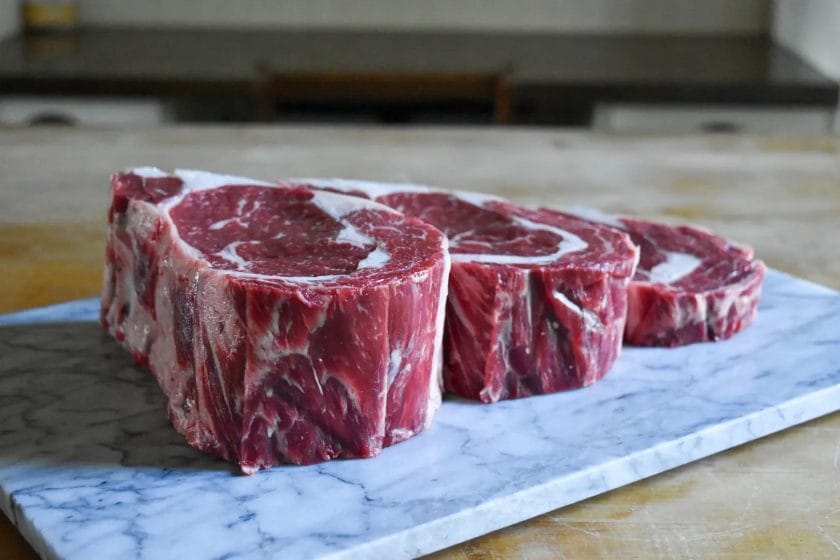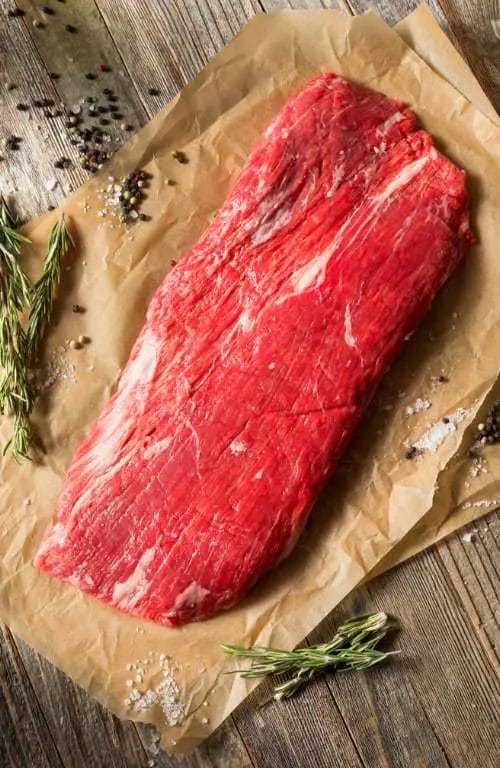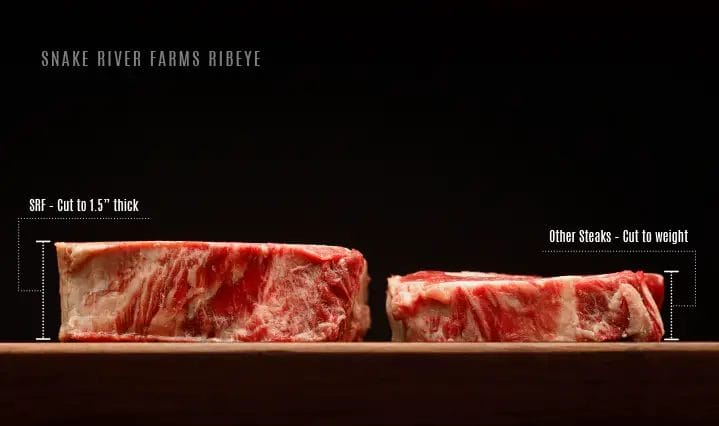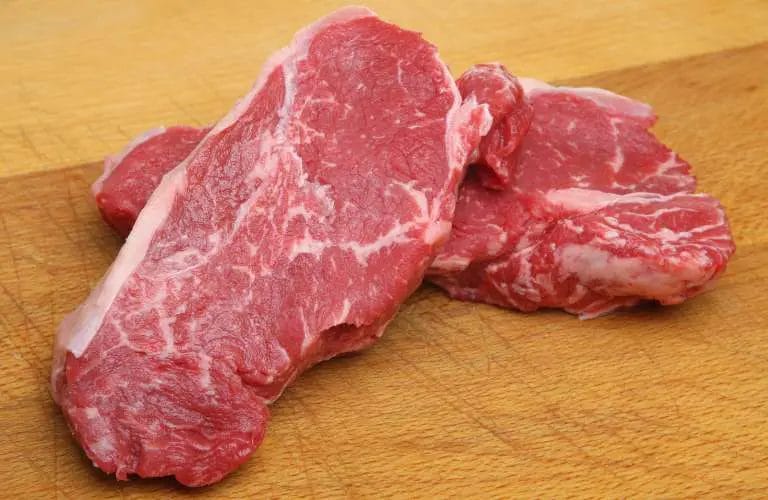Choosing the best thickness for a steak can greatly impact its taste and texture. A thickness of around 1 to 1.5 inches is generally recommended for optimal results. This thickness allows for a nice sear on the outside while ensuring the inside cooks evenly.
Thicker cuts are great for grilling or slow cooking, as they retain moisture and tend to be more tender. Thinner cuts, on the other hand, are ideal for quick cooking methods like pan-frying or broiling. Ultimately, the best thickness for a steak depends on your cooking method and personal preference.

The Importance of Steak Thickness: Finding the Perfect Cut
When it comes to grilling that perfect steak, many factors come into play – the quality of the meat, the marinade, the cooking technique, and so on. However, one often overlooked aspect of steak preparation is the thickness of the cut.
In this section, we will explore why the steak thickness matters and how to find the perfect cut for your next barbecue.
1. Even Cooking
The thickness of a steak affects its cooking time and how evenly it cooks. A thin steak will cook quickly, resulting in the outside being overcooked while the center remains undercooked.
On the other hand, a thick steak may take too long to cook, leading to an overcooked exterior and an undercooked center. The goal is to achieve the perfect level of doneness throughout the entire steak.
A steak that is around 1 to 1.5 inches thick is considered ideal for grilling. This thickness allows for a beautiful sear on the outside while ensuring the interior is cooked to perfection.
2. Juiciness and Tenderness
The thickness of a steak also affects its juiciness and tenderness. A thicker steak retains more moisture during the cooking process, resulting in a juicier end product.
The increased thickness also allows for more time for the collagen and connective tissues to break down, resulting in a more tender steak.
Thinner steaks tend to be drier and may lack the desired level of tenderness. By choosing a thicker cut, you can ensure a more succulent and flavorful steak.
3. Flavor Development
When grilling a steak, flavor development is a key consideration. A thick steak provides more surface area for the development of a beautiful crust or char, which enhances the overall flavor profile of the meat. The natural sugars and proteins in the steak react with the heat, creating a delicious maillard reaction.
A thinner steak may not have enough surface area to develop this desirable crust, resulting in a less flavorful eating experience.
4. Versatility in Cooking Methods
Choosing the right thickness for your steak opens up a world of cooking possibilities. A thicker steak can be cooked to a perfect medium-rare on the grill, giving it a delightful charred exterior and a pink, juicy center.
However, it can also be seared in a hot cast-iron skillet and finished in the oven for a restaurant-style steakhouse finish.
Thinner steaks, while quick to cook, may limit your cooking options. They are best suited for high-heat cooking methods like stir-frying or pan-searing.
Factors to Consider when Choosing the Thickness of Your Steak
Choosing the right thickness of steak is crucial to ensure that you get the perfect cook and optimal flavor. The thickness of the steak directly affects the cooking time, the level of doneness, and the overall juiciness of the meat.
In this section, we will discuss the key factors that you should consider when selecting the thickness of your steak.
Cut of the Steak
The first factor to consider is the cut of the steak. Different cuts have different textures and levels of tenderness. Some cuts, like ribeye or filet mignon, are naturally more tender and therefore require less cooking time.
These cuts are ideal for thicker steaks as they can retain their juiciness even with longer cooking times.
On the other hand, tougher cuts like flank or skirt steak benefit from being thinly sliced or pounded to tenderize the meat. Thicker cuts of these steaks may result in a chewier texture, so it is advisable to opt for thinner cuts for these types of steaks.
Preferred Level of Doneness
Another important factor is your preferred level of doneness. The thickness of the steak plays a role in achieving the desired level of doneness. Thicker steaks take longer to cook, which means they have a longer window to reach the desired internal temperature without getting overcooked on the outside.
If you prefer your steak rare or medium-rare, a thicker cut is recommended to ensure that the steak is cooked perfectly on the inside while maintaining a seared crust. Thinner steaks may cook too quickly, resulting in a more well-done steak.
Cooking Method
The cooking method you choose also influences the ideal thickness of your steak. For grilling or broiling, thicker steaks are preferable as they can withstand the high heat and retain their juiciness. Thicker steaks also allow for a better charred crust while keeping the interior tender and moist.
On the other hand, if you plan to pan-sear or stir-fry your steak, thinner cuts are more suitable. Thinner steaks cook quickly and evenly, allowing for a nice sear without overcooking the meat.
Personal Preference
Lastly, your personal preference plays a significant role in determining the ideal thickness of your steak. Some people enjoy the mouthfeel and texture of thicker cuts, while others prefer thinner steaks that cook quickly and have a more well-done center.
It is essential to consider your own taste preferences and cooking methods when deciding on the thickness of your steak. Experiment with different thicknesses to find the perfect balance of tenderness, juiciness, and level of doneness that suits your palate.

Thin vs Thick: Exploring the Benefits and Drawbacks of Different Steak Thicknesses
Steak lovers often find themselves faced with the dilemma of choosing between thin and thick cuts of meat. While both options have their merits, it’s important to understand the benefits and drawbacks of each before making a decision.
In this section, we’ll delve into the world of steak thicknesses and examine how they can affect the overall dining experience.
Thin Steak
Thin steaks are typically cut to be less than an inch thick, often around 1/2 to 3/4 inch in thickness. These steaks are known for cooking quickly and evenly due to their reduced mass. Here are some of the advantages and disadvantages of opting for a thin steak:
Advantages
- Quick cooking time: Thin steaks cook rapidly, making them an ideal choice for those who prefer their steak cooked to medium-rare or medium.
- Even cooking: Due to their reduced thickness, thin steaks tend to heat up evenly, resulting in a consistent doneness throughout the meat.
- Tender texture: Thin steaks are less likely to have a chewy texture due to their faster cooking time, resulting in a more tender and juicy bite.
- Versatile: Thin steaks can be used in various recipes, such as stir-fries or fajitas, where quick cooking is essential.
Drawbacks
- Limited doneness options: Thin steaks do not provide as much leeway for different doneness preferences. Achieving a well-done steak without overcooking the exterior can be challenging.
- Less robust flavor: The reduced thickness of the steak may result in a slightly milder flavor compared to thicker cuts.
- Higher risk of drying out: Thin steaks are more prone to drying out if cooked for too long or at high temperatures.
Thick Steak
Thick steaks, often measuring over an inch in thickness, offer a different dining experience compared to their thinner counterparts. Here are some advantages and disadvantages of choosing a thick steak:
Advantages
- Customizable doneness: Thick steaks allow for a wider range of doneness options, from rare to well-done, providing more flexibility for individual preferences.
- Bolder flavor: The increased thickness of the steak can result in a more pronounced and robust flavor profile.
- Juicier center: The additional thickness allows for a larger pink center, providing a juicier and more succulent bite.
- Enhanced sear: Thick steaks are well-suited for achieving a perfect sear on the outside while maintaining a tender interior.
Drawbacks
- Longer cooking time: Thicker steaks require more time to reach the desired doneness, which may not be suitable for those who prefer a quicker cooking process.
- Less even cooking: The increased thickness can make it challenging to achieve uniform doneness throughout the steak, resulting in variations in texture.
- Reduced versatility: Thick steaks may not be as suitable for quick-cooking recipes that require thinly sliced meat.
Achieving the Perfect Steak: Choosing the Ideal Thickness for Your Preferred Cooking Method
When it comes to cooking the perfect steak, choosing the right thickness is crucial. The thickness of the steak determines how it cooks, and different cooking methods require different thicknesses to achieve the desired result.
In this section, we will discuss the importance of selecting the ideal thickness for your preferred cooking method.
1. Thin Cut Steaks
Thin cut steaks, typically around 1/2 inch thick, are perfect for quick cooking methods such as grilling or pan-searing. These steaks cook rapidly and require high heat to achieve a mouthwatering sear on the outside while keeping the center juicy and tender.
The thinness allows the heat to penetrate quickly, resulting in a steak that is cooked to perfection in just a few minutes. Thin cut steaks are a popular choice for those who prefer their steaks rare to medium-rare.
2. Medium Cut Steaks
Medium cut steaks, around 1 inch thick, are the most versatile option when it comes to cooking steaks. They are suitable for a wide range of cooking methods, including grilling, pan-searing, and broiling.
The slightly thicker cut provides a balance between tenderness and cooking time. Medium cut steaks are ideal for those who enjoy a medium-rare to medium doneness, as they allow for a bit more control over the cooking process.
3. Thick Cut Steaks
Thick cut steaks, approximately 1 1/2 to 2 inches thick, are perfect for special occasions or for those who prefer their steaks cooked to medium or well-done.
The thickness of these steaks allows for a more gradual cooking process, ensuring that the center of the steak reaches the desired doneness without overcooking the outer layers.
Thick cut steaks are best suited for cooking methods that involve indirect heat, such as grilling over low heat or using a reverse sear technique.
4. Extra Thick Cut Steaks
If you’re looking to impress your guests or indulge in a truly decadent steak experience, extra thick cut steaks are the way to go. These steaks, typically 2 inches or more in thickness, require a longer cooking time to ensure that the center is cooked to perfection while maintaining a juicy and tender texture.
Extra thick cut steaks are best suited for slow cooking methods, such as sous vide or smoking, where the low and slow approach allows the steak to develop intense flavor and tenderness.

Expert Tips for Cooking Steaks of Different Thicknesses to Perfection
When it comes to cooking steaks, achieving the perfect level of doneness can be a challenge. This is especially true when dealing with steaks of different thicknesses. The thickness of the steak plays a significant role in determining the cooking time and temperature required to achieve the desired result.
In this section, we will provide you with expert tips on how to cook steaks of different thicknesses to perfection.
1. Choosing the Right Cooking Method
The cooking method you choose can greatly impact how well your steak cooks. When it comes to steaks of varying thicknesses, it is important to select a method that allows for even cooking. Here are a few options:
- Grilling: Grilling works well for steaks that are 1 inch or thicker. The direct heat from the grill helps to sear the steak, locking in its juices and creating a delicious charred exterior.
- Searing and Oven-Finishing: For thicker steaks, you can start by searing the steak on high heat for a few minutes on each side. Then, transfer it to a preheated oven to finish cooking to the desired doneness.
- Sous Vide: Sous vide is a cooking technique that involves vacuum-sealing the steak and cooking it in a temperature-controlled water bath. This method ensures even cooking throughout the steak, regardless of its thickness.
2. Adjusting Cooking Time
The cooking time for steaks of different thicknesses will vary. Thicker steaks will require more time to cook compared to thinner ones. Here’s a general guideline to help you adjust the cooking time:
- For a 1-inch thick steak: Cook for approximately 4-5 minutes per side for medium-rare.
- For a 1.5-inch thick steak: Cook for approximately 5-6 minutes per side for medium-rare.
- For a 2-inch thick steak: Cook for approximately 6-7 minutes per side for medium-rare.
- Remember to adjust the cooking time based on your preferred level of doneness.
3. Using a Meat Thermometer
A meat thermometer is a valuable tool when it comes to cooking steaks. It allows you to accurately measure the internal temperature and ensure that your steak is cooked to perfection. Here are the recommended internal temperatures for different levels of doneness:
- Medium-Rare: 135°F (57°C)
- Medium: 145°F (63°C)
- Medium-Well: 150°F (66°C)
- Well-Done: 160°F (71°C)
Insert the meat thermometer into the thickest part of the steak to get an accurate reading. Once the steak reaches your desired internal temperature, remove it from the heat and let it rest for a few minutes before serving.
4. Adjusting Heat Levels
When cooking steaks of different thicknesses, it is essential to adjust the heat levels accordingly. For thicker steaks, you may need to reduce the heat slightly to allow for even cooking without burning the exterior. For thinner steaks, a higher heat can be used to achieve a desirable sear.
5. Resting the Steak
Resting the steak is a crucial step in the cooking process. After removing the steak from the heat source, let it rest for a few minutes before slicing into it. This allows the juices to redistribute throughout the meat, resulting in a more tender and flavorful steak.

FAQs
What is the best thickness for a steak?
The best thickness for a steak is typically around 1 to 1.5 inches. This allows for a good balance between a caramelized crust and a perfectly cooked interior. Thicker steaks may require longer cooking times, while thinner cuts can be prone to overcooking or drying out.
Conclusion:
In conclusion, determining the best thickness for a steak is a matter of personal preference and cooking technique. Whether you prefer a thick, juicy cut or a thinner, faster-cooking steak, the choice is ultimately up to you.
However, keep in mind that thicker steaks require longer cooking times and may result in a more rare center. On the other hand, thinner steaks cook quickly and are ideal for achieving a medium or medium-well doneness.
Experimenting with different thicknesses will help you discover your preferred steak thickness, ensuring a perfectly cooked and delicious steak every time.

